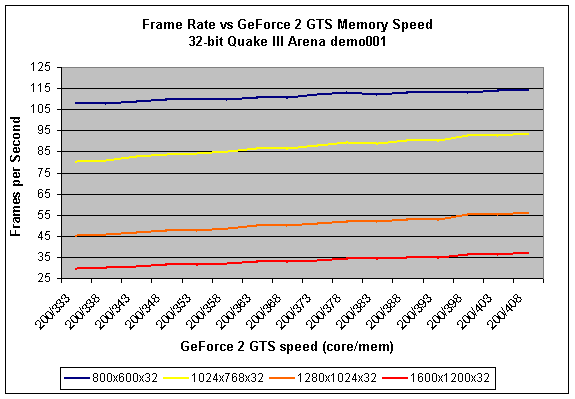NVIDIA GeForce 2 GTS Roundup - July 2000
by Matthew Witheiler on July 10, 2000 4:39 AM EST- Posted in
- GPUs
Overclocking The Memory
The new approach to overclock the GeForce 2 GTS was to overclock the other component of video card speed: the memory. As mentioned in the previous GPU section, the GeForce 2 GTS has a very impressive fill rate of 1.6 gigatexels per second. The problem is that each one of these texels has to pass to and from the on card memory before it can actually be displayed on screen. Since the total video card speed is only as fast as its slowest component, a less than impressive 333 MHz DDR stock memory speed on GeForce 2 GTS based cards provided for an enormous system bottleneck. Just how large is this bottleneck? To find out, we maintained a constant core speed of 200 MHz and slowly increased the memory speed by 5 MHz, as illustrated by the graph below.

As can be seen, the story becomes quite a bit different when overclocking the memory. No longer are those extra megahertz wasted. Overclocking the memory on our GeForce 2 GTS based card provided for quite a kick in the pants. This is due to the fact that the GeForce 2 GTS will never realize its full potential when on a 333 MHz memory pipeline, bringing down that 1.6 gigatexel per second theoretical fill rate to produce what is referred to as an effective fill rate: how fast the card actually goes. More information on this topic can be found in the full Overclocking Guide.
For this roundup we also had a chance to investigate the benefits, if any, of RAM heatsinks. We found that while the heatsinks do reduce RAM temperature marginally, by 2 degrees Fahrenheit in the case of the Absolute Multimedia Outrageous GeForce 2 GTS, they do not increase the maximum overclockablity of the RAM. This can be seen by comparing the Absolute Multimedia's maximum memory speed with the RAM-sinks on to the maximum memory speed of the heatsink-less ASUS V7700. The Absolute Multimedia card was able to hit 390 MHz while the ASUS V7700, which features the same RAM, was able to hit 405 MHz, which just goes to show that heat is not a factor in maximum memory speed.










0 Comments
View All Comments